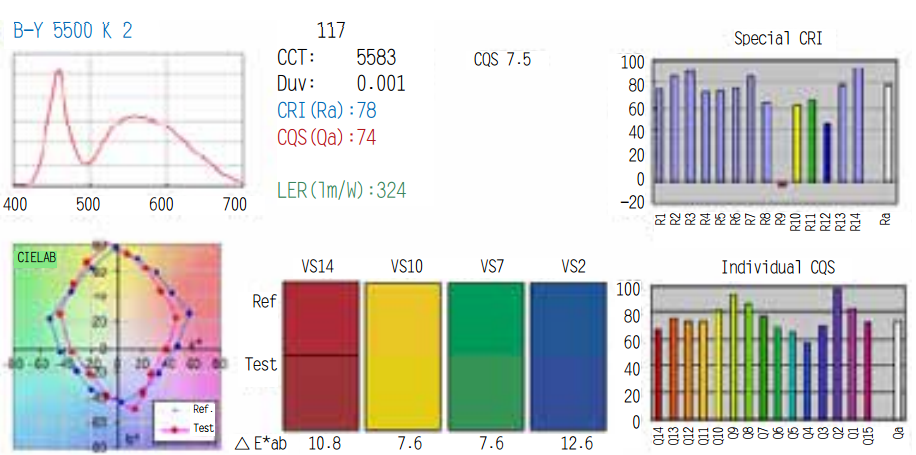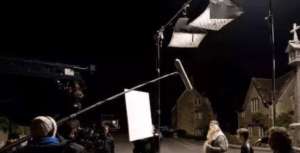Color Fidelity is Only One Aspect of Light Color Quality
CRI evaluates the color fidelity by calculating the color difference between the light source to be measured and the reference illuminator (the reference illuminator may be the light source, or may not be the actual light source) by calculating a set of pre-selected color samples. It has been known for a long time that color fidelity is not the only indicator of white light quality. CQS (Color Quality Scale) also contains some other aspects, in particular, increasing the color saturation (ie chroma) of the object can enhance visual satisfaction, color resolution and visual clarity, and can also improve the brightness of the illuminated object. Subjective evaluation of color appearance. In addition, it is known that the color saturation of objects perceived when the illuminance level is low is reduced (the Hunt effect).
CQS is basically a fidelity system, and the results obtained are similar to Ra, but CQS has many improvements, including its ability to consider the direction of the object’s color shift. Therefore, the value of CQS can be well in line with the visual evaluation of color-enhanced light sources; it can also give accurate fidelity values for non-color-enhanced light sources. That is to say, for all light sources, the value of CQS can represent the complete color quality of the product.
High CRI value does not guarantee good light color quality
One of the problems with CRI is that some light sources have very poor color rendering of saturated colors, but the value of CRI is very high. Figure 1 is a case of a light source formed by mixing red-green-blue (RGB) LEDs. The white light LED is simulated to have the maximum radiant light effect (LER, in lm/W) when Ra=80 (radiant light effect LER is the light effect when all input electrical energy is converted into visible light).
The simulated white LED will be able to meet the Energy Star (Energy Star) requirements, with high luminous efficiency, but its true color rendering is not good. Because of its R9=-114, the skin appears pale and unhealthy under the illumination of this light source.
The CQS value of this light source is 7 points lower than its CRI value, so it cannot meet the requirements of Energy Star for LED lamps. The leading proposal in CIE TC, CRI-CAM02UCS, gave this light source a score of 81, which is even a little higher than CRI.
The color blocks shown in the figure below are 4 of the 15 color samples used in the CQS system. The upper half of these color blocks is the situation of the reference illuminator (in this case, the black body), and the lower half is the result of the simulated light source. The colors shown in the figure are all obtained by colorimetric simulation.
White LED light source made of red-green-blue (RGB) LED color mixing
The phosphor-converted white LED (P-LED) has the same problem for saturated object colors, but it is not as serious as the above example. In the example in Figure 2, the CRI is close to 80 (78), but the color rendering of red objects is poor (R9 is a negative value). In addition, the hue shift from blue to purple is also obvious. For this light source, the value of CQS is 4 points lower than CRI. (Please note that although the value of CQS is 4 points smaller than the value of CRI in this example, for most P-LEDs, the value of CQS does not deviate much from the value of CRI.)
The above-mentioned problem occurs because the color samples used by CRI are not high in saturation, so there is a problem with the re-display of high-saturation colors. It is precisely because of these problems with CRI that some adjusted specifications have also added requirements for R9 or even R10, R11 and R12 (special color rendering index for saturated colors) on the basis of Ra.
But under normal circumstances, users only know Ra. Under normal circumstances, the industry and users do not want to use a few numbers to express the color rendering index. CQS uses saturated color samples as test samples to calculate. It uses only one number Qa to indicate the color rendering index of all colors including saturated colors.
The CQS system has another advantage: if a light source has very poor color rendering for one or two colors, even if the color rendering for all other colors is good, its CQS value will be significantly reduced (just like the previous RGB LED example).
Phosphor converted white light LED (P-LED)
CRI has given unfair treatment to color-enhanced light
As mentioned earlier, when the light increases the saturation of the color of the object, the value of CRI cannot be consistent with the visual perception. The light can produce a slight increase in the color range (in the figure is the area enclosed by the red dot and the red line, which is slightly larger than the area enclosed by the blue line), and the color contrast of the object is also slightly enhanced. Under the lighting of the lamp, the color of the object looks vivid and beautiful. This lamp often beats ordinary incandescent lamps. But the Ra of ordinary incandescent lamps is 100, while the Ra of neodymium lamps is only 77. The visual perception suggests that this lamp deserves a better evaluation. Sure enough, the CQS value of this lamp is not 77, but 88.
Narrow-band spectrum RGB LED light sources will produce a similar color enhancement effect. The Ra of this light source is only 71, but we see that the objects under its illumination are beautiful and natural. This light source deserves a better evaluation.
In this color demonstration studio, we used another RGB LED luminaire for lighting. Compared with the previous RGB LED luminaire, only the red peak position is changed. From this example, we can see the effect of color saturation reduction. The Ra=82 of this light source is much higher than the previous example (11 points higher), but we found that the object looks very poor under this light.
The visual effects of the two light sources in the above two examples are compared. As a result, although the colors in these two photos may not be reproduced completely accurately, the effect is still clear. We found that color-enhanced light has better lighting effects than color-unsaturated light. Due to the Ra value, the color-enhanced light reaches the Energy Star standard, while the color-unsaturated light cannot. But if CQS is used for evaluation, the situation is reversed.
Consistent with traditional light source CQS and CRI
CRI has been widely used in the lighting industry for more than 40 years. Traditional bulb manufacturers are very concerned about whether their current products adopt a new evaluation system, whether the value obtained will be different from the value of CRI, especially for three-primary fluorescent lamps. Since the 1980s, CIE has tried several times to revise the CRI. The most recent one was an effort by TC-33, but they were all unsuccessful. The design of CQS is to solve these existing problems while ensuring that the results obtained for existing lamp products are consistent with the value of CRI.
Other improvements of CQS system
Compared with CRI, CQS has several improvements. People often find that it is difficult to distinguish dark blue socks from black socks under incandescent lighting. This is because when the correlated color temperature is low, the energy of the short wavelength (ie blue) is small, and the range of object colors that can be presented is reduced. .
For example, although the color rendering index of the CRI system for 2000K blackbody is Ra=100, in fact such a reddish light is not suitable for general lighting. In the CQS system, in order to express this effect on the light source with very low color temperature, a “CCT factor” is introduced based on the range of object color presented by the reference illuminator, so that the Qa value of the light source with very low color temperature is reduced. The CCT factor only affects light sources with a color temperature below 3000K. For example, for a 2800K incandescent lamp (and other light sources with the same color temperature), the value of Qa is only reduced by 2 points.
The CQS system also eliminates outdated formulas used in CRI calculations. The object color space W*U*V* used in the CRI system is very uneven and cannot accurately measure the color difference of the object. Replaced by the recent CIE standard color space CIE LAB.
The old color adaptation formula (von Kries transformation) used in the CRI system was also replaced with CMCCAT2000. As a result, the CQS system will slightly penalize the chromaticity point (the chromaticity point above the blackbody locus—yellowish or greenish light) with a large positive value for the chromaticity difference Duv, so that its Qa value is reduced, but This is not the case with the CRI system. The value of Qa is consistent with the results of our visual test. Compared with the pink light with the same Duv offset value, the green light has a worse lighting effect.
In addition to the Qa value, the CQS system also provides the classification values Q1-Q15 for various saturated colors for professional use. You can also add more color samples (for example, add skin color like the CRI system), but these color samples are not used for Qa calculations.
Similar to CRI, the value range of CQS is 0-100. The difference between the two is that the former will have confusing negative values, while CQS has Qa=0 for light sources without color rendering capabilities (such as low-pressure sodium lamps). This change will only affect the evaluation value of light sources with very low color rendering properties (Ra less than 30).




